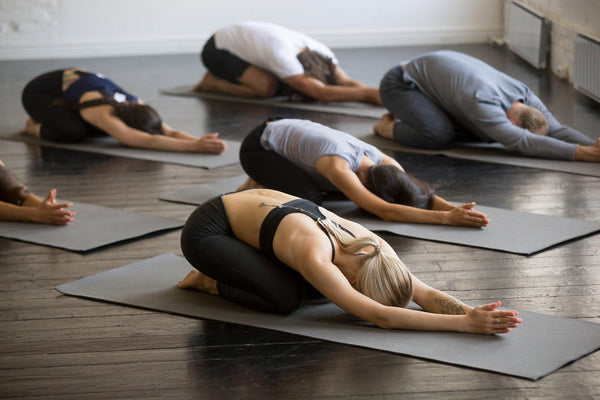Getting Started: Yoga Styles to Meet You Where You Are
If you look at a yoga class schedule, you might be overwhelmed before you even step on the mat. So many names! So many styles! Which one is right for you?
When you're getting ready to start a yoga practice, it helps to have an idea of what to expect from certain class styles. First, reassure yourself: these tips will get you through your first class, even if you end up in one that's a bit more challenging than you expected. Then, get excited! We'll take a look at some of the more popular beginner-friendly yoga styles you might see on the studio schedule. They're all yoga—they're all good!—and eventually, you may want to try them all!
Get prepared, and you can make almost any class meet you where you are:
- Choose with Purpose: Don't jump into advanced yoga if you've never done yoga. Don't try hot yoga if you've been living a sedentary lifestyle, as the extra heat combined with the physical exertion adds up quickly. Find a class that allows you to move slowly with a deeper explanation of what you're doing and what's coming next. Look for a class with "Beginner" or "All-Levels" in the name.
- Get the Right Equipment: Sometimes people don't want to buy a good yoga mat because they're afraid they won't stick to the practice, but a low-quality mat can actually make your practice more difficult. If the mat isn't sticky enough, you may have a hard time holding poses. If it's too thin, it might be uncomfortable when you kneel or lie down. Buying a high-quality mat, along with accessories like blocks and straps, can make the practice more accessible—and may make you more likely to keep going!
- Tell the Teacher You're New: Even if an intermediate class is the only one that fits in your schedule, your teacher should still be ready and willing to keep an eye on you, offer modifications and adjustments, and make you feel welcome and capable even if you're not doing the most advanced version of a particular pose.
- Go at Your Own Pace: This is about you. It doesn't matter what anyone else in the room is doing. Listen to your body. If you know a particular pose is not right for you yet, don't do it. You don't have to do every pose to have a wonderful practice! Focus on your breath and on staying present, and do the physical work you can do. Know you'll improve physically with time, but the mental and emotional aspects of your practice are every bit as important—if not more so.
- Stay Calm: If you find yourself in a class that definitely isn't right for you, take a deep breath. You have options! First of all, you can leave. Do so quietly and respectfully, but know it's okay to do that. However, it's worth it to take a moment and ask yourself why you're leaving. Don't let your ego get the best of you! That's what this practice is all about. Is it possible to stay and do gentler versions of the poses? Is there something you can learn from a teacher you don't particularly like? Can you sit or lie quietly and focus on your breath instead of following along? This is your yoga, and there are no wrong answers.
- You're Not Alone: Everyone starts somewhere. This is your yoga journey, and it begins now. Like Arthur Ashe said,
"Start where you are. Use what you have. Do what you can."

Take a look at what you can expect from a few of the beginner-friendly styles you might see on the schedule:
Hatha
All physical yoga is hatha yoga. "Ha" means sun, while "tha" means moon, so Hatha refers to the balance of those energies via physical yoga postures. Still, when Hatha shows up on a schedule, it's usually a gentler class and may be a good place for a beginner. Talk to the studio and the teacher about how he or she teaches it.
Gentle
As a generic term, gentle classes typically offer a slower pace with poses that are easier to maintain. Gentle yoga teachers may have a background in a variety of yoga disciplines—you could have a gentle vinyasa class or a gentle Iyengar class. You'll find fellow beginners as well as those who are recovering from injuries or simply looking to relax and unwind.
Yin
In a yin class, you can expect deep stretching poses that are held for a long period of time—sometimes five minutes—that help you improve flexibility and open up the connective tissue around your joints. Most of the poses are focused on the lower body. It's okay if you're not flexible: your teacher will help you find a position you can maintain, and you will improve over time. This is an especially good choice if it takes you some time to move in and out of positions since once you are in a yin pose, you won't be expected to rush out of it.
Restorative
These classes rely on cushions, bolsters, and other props to help you settle into deeply relaxing poses. Know this: It. Is. The. Best! Restorative classes help reduce stress and anxiety while gently stretching the body and breathing deeply; you'll walk out feeling like a new person. You might only do six to 10 poses in the entire class, as you take time to carefully set up the props to give you the most comfortable, effortless experience; at that point, poses are held for several minutes.
Iyengar
Though these classes can be physically advanced as well as gentle, there's a strong focus on precise alignment. Blocks and other props are used to help you use your body properly in the pose, so the pace is usually a little slower.
Yoga Nidra
This isn't yoga as you're imagining it: instead, it's a deep guided meditation and relaxation. You'll lie comfortably on the floor the whole time! It's even better than an afternoon nap, if you can imagine.
You may be wondering about other class styles, such as vinyasa, Ashtanga, power yoga, Bikram, and more. Typically, many of these styles are faster-paced and more intense.
If you come from an athletic background and have been exercising, you might feel right at home in a vinyasa class, for example, even if you've never done yoga before. Vinyasa classes feature a serious of postures linked through flowing movement and generally designed to build strength and get you sweating! The extreme heat and rigid guidelines of a Bikram class (which you'll only find at Bikram studios) might not feel as overwhelming as they would if you're starting a fitness journey alongside your yoga journey. Ashtanga can become quite challenging and tends to have a reputation for that, but your teacher will help you adapt to the poses. Ashtanga features the same poses in order each time, so you'll be able to learn them and practice as you go.
"Yoga begins right where I am—not where I was yesterday or where I long to be." Linda Sparrowe
It doesn't matter what brings you to the mat. Many people start their yoga journey for the many physical benefits, but with continued practice you'll notice other benefits, too: greater peace of mind, less stress, and more confidence. Get curious about what may emerge for you. Get curious enough to take that first class.
In the end, there is no one size fits all, even among beginners. A good teacher will make you feel welcome no matter your level, and will help you adapt to the class or find one that is better suited to you. Visit a few studios and find one where you feel at home as you develop your practice.
If you've enjoyed this post, or would be interested in more posts of this type, please let us know here.


